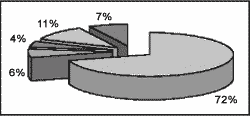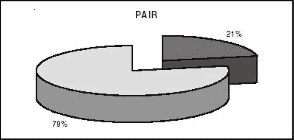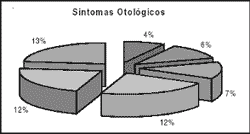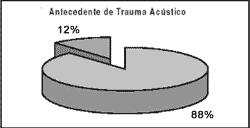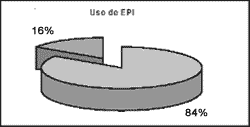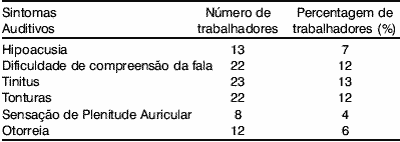

Year: 2002 Vol. 68 Ed. 1 - (8º)
Artigo Original
Pages: 47 to 52
Noise induced hearing loss in metallurgical workers
Author(s): Simone Adad Araújo 1
Keywords: hearing loss, occupational noise, metallurgist.
Abstract:
Introduction: Noise induced hearing loss is a cumulative pathological disease that increases over the years with exposure to noise associated with the work atmosphere. Objectives: To identify and quantify the occurrence of hearing loss suggestive of Noise Induced Hearing Loss (NIHL) and the principle otolaryngological symptoms referred to by workers. Study design: prospective clinical randomized. Material and method: Research was carried out from January to March of 2000 with 187 metallurgical workers in the city of Goiânia, who were evaluated by otolaryngologists by means of a combination of interviews and occupational hearing exams. Results: Occupational hearing tests results were: 21% suggestive of NIHL, 72% normal, and 7% suggestive of other hearing impairments. The most frequent hearing symptoms were: difficulty of comprehension in speaking 12%, Hearing loss 7%, Tinnitus 13%, Auricular fullness feeling 4%, Effusion 6%, and Dizziness 12%. Conclusion: We concluded that in metallurgist exists an occurrence of hearing loss suggestive of NIHL and complaints of significant otolaryngological symptoms.
![]()
1 Specialist in Occupational Medicine, Medical School of Itajubá. Master degree in Otorhinolaryngology, Medical School of Ribeirão Preto, University of São Paulo and Doctorate Studies in Otorhinolaryngology under course, Medical School, University of São Paulo.
Address correspondence to: Rua 20, número 324, ap. 201, Setor Central Goiânia, Goiás - 74030-110
Tel: (55 62) 224.2282 - E-mail: saadad@bol.com.br
Article submitted on September 06, 2001. Article accepted on October 05, 2001.
INTRODUCTION
Noise is a type of sound that causes harmful effects on humans, characterized by an unpleasant sensation that interferes in the perception of the target sound. Noise induced hearing loss (NIHL) is a cumulative and insidious pathology that increases as a result of years of exposure to noise associated with occupational environment. It is caused by any exposure of about 90dB for 8 hours a day, for many years. Noise induced hearing loss is an irreversible disease that has progressive evolution and may be prevented.
Reports that suggested that workers in noisy environments were subject to hypoacusis and occupational deafness were initially made by Mocelin7, 1951, who advocated at the time individual prophylaxis and use of personal protective equipment during work.
The four possible mechanisms of Corti's organ damage were reported by Lim and Dunn9, 1979, and affect preferably the basal cochlear spiral, at the site responsible for sound of 3 to 6kHz, regardless of the frequency spectrum of the aggressive sound, being:
1) vascular insufficiency in the cochlear region responsible for hearing at 4kHz;
2) the speed of sound wave propagation is very high and makes amplitude of dislocation in the cochlear duct to increase in the region of 4kHz;
3) anatomical structure of the cochlea causes liquid clash in the first cochlear curve;
4) resonance characteristics of the auditory canal would cause damage to the referred area9.
As referred by Seligman and Ibañez12, 1993, chronic exposure to noise produces slow, progressive and irreversible hearing deterioration with characteristics of symmetrical sensorineural hearing loss. The patients may complaint of tinnitus, hypoacusis, fatigue, decreased work performance, neurovegetative alterations, stress and they are consequently prone to develop other organic illnesses.
Excessive noise may damage significantly the auditory pathways, from the tympanic membrane up to the regions of the central auditory system. In Corti's organ, the main alterations responsible for noise induced hearing loss take place because the outer hair cells are especially sensitive to high and prolonged sound pressures, the so-called "metabolic extension", with enzymatic and energetic depletion and reduction of oxygen and nutrients. After cellular death, the space is filled with scarring tissue, leading to permanent deficit of hearing capacity.
Noise induced hearing loss is the consequence of prolonged exposure to a noisy environment, with two key aspects: noise characteristics and individual susceptibility.
Noise characteristics are: intensity, frequency, duration of exposure and nature of noise. Intensity as from 84/90 dB causes irreversible cochlear damage and the louder the noise, the more severe the damage, which has been the case in some occupational environments such as metallurgy, textile settings, engine testing facilities, and others. As to frequency, any area of the sound spectrum is capable of triggering cochlear problems, and the most traumatic ones are sounds that consist of high frequencies. As to duration of exposure, the damage is directly proportional to the time the subject has been exposed to noise; after 100 hours of exposure, we can find irreversible cochlear pathology and that is the reason why acoustic rest intervals are essential to try to recover enzymatically the sensorial cells. The nature of noise refers to the distribution of sound energy over time, and it may be continuous, fluctuating or intermittent. Impact noise, such as an explosion, is particularly harmful.
Individual susceptibility is related to gender, age and ear diseases. Incidence and severity of hearing loss are more marked in male subjects. Age is an important factor because the youngest and the eldest are more susceptible. Ear diseases with sensorineural hearing loss of any etiology may add further harm to the patient that is exposed to noise.
Diagnosis of NIHL should be performed based on clinical history of exposure to noise, ENT examination focused on otoscopy and pure tone audiometry. Assessed frequencies are the traditional ones, plus the frequencies of 3kHz and 6kHz. The assessed worker, before the test, has to have 14 hours of acoustic rest to prevent detection of temporary hearing disorders.
Seligman13, 1994, characterized NIHL as sensorineural, irreversible and almost always similarly bilateral hearing loss that rarely takes to profound hearing loss because it rarely exceeds 40dB thresholds in low frequencies and 75dB thresholds in high frequencies, manifesting first and predominantly in the frequencies of 3, 4 and 6 kHz, and as a result of progression, the damage extends to frequencies of 8; 2; 1; 0.5 and 0.25 kHz, which take longer to be impaired. The patient who has NIHL may present intolerance to loud sounds, tinnitus and impairment of speech intelligibility, compromising the whole communication process. If noise exposure is interrupted, there is no progression of NIHL. The loss normally reaches the maximum level in frequencies 3, 4 and 6 kHz in the first 10 to 15 years of exposure under stable conditions of noise.
The author reported that NIHL can be aggravated by simultaneous exposure of workers to loud noise and other agents, such as chemicals and vibration. Similarly, the worker that takes ototoxic drugs or has other pathologies is more susceptible to noise damage.
Costa3, 1994, reported that the effects depend on intensity and duration of noise exposure, but despite the great knowledge we have about the damage to the auditory system, we do not know enough about effects on the extra-auditory system, such as physical and psychical alterations caused by noise.
Loud noise may act as a predisposing agent to the occurrence of industrial accidents, according to Leite and Souto5, 1996, and it may also be an aggravating cause of cardiovascular and endocrine diseases by action of the autonomic nervous system.
Occupational noise is a dangerous pollutant agent, according to Seligman9, 1997, which is one of the most common pollutants among the various present in industrial facilities. Auditory symptoms are normally represented by hearing loss, tinnitus and difficulties to understand speech. Extra-auditory symptoms are sleep disorders and communication difficulties and neurological, vestibular digestive, behavioral, cardiovascular and hormonal disorders.
The importance of noise exposure in occupational environments and the occurrence of noise induced hearing loss especially in metallurgy was described by Benevides2, 1997.
The need to use personal protective equipment to reduce the mechanical action of noise and the importance of having Hearing Preservation Programs in industries where workers are exposed to 85dB were reported by Lusk6, 1997.
In the Hearing Preservation Programs, according to Nepomuceno9, 1997, acoustic measures are important and they involve sound pressure level and time to determine levels of noise exposure. Information collected from personal monitoring are essential for the selection of personal protective equipment, such as control and analysis of occupational audiometries.
The maximization between noise and exposure to chemical agents was also referred by Morata8, 1998.
The present study intended to identify the occurrence of noise induced hearing loss and the main otological symptoms, plus the use of personal protective equipment, in workers of a metallurgy industry in the municipality of Goiania between January and March 2000.
Material and method
After the approval by the Ethics Committee, the study was conducted in a metallurgy industry located in the municipality of Goiania from January to March 2000.
We selected 187 workers whose workstations were in noisy environments, above 85dB. They were adults, ranging in age from 18 to 50 years, assessed by means of a screening protocol that consisted of history and occupational audiometry.
The history had two parts: identification and hearing screening, aiming at investigating the main otological complaints of workers. Identification: name, age, gender, function, time in the company, working hours and use of personal protective equipment (PPE). Hearing screening - we asked about otological symptoms, systemic diseases and history, otological symptoms, such as hypoacusis, difficulty to understand speech, tinnitus, otalgia, ear fullness, dizziness and others; systemic diseases, such as diabetes, syphilis, measles, mumps, meningitis, tuberculosis, arterial blood hypertension, thyroid diseases, renal diseases and others that could be related to the presence of hearing loss. History of acoustic trauma, exposure to noise in previous jobs, family history of deafness, use of ototoxic, work with solvents, smoking, use of daily medication and other factors that could influence hearing.
We conducted ENT assessment with otoscopy in all assessed subjects, which was normal in all of the patients submitted to pure tone audiometry.
Pure tone audiometry was performed in frequencies 250 Hz, 500 Hz, 1 kHz, 2 kHz, 4 kHz, 6 kHz and 8 kHz, by a team of two audiologists, using the calibrated audiometer brand Maycos, in all selected subjects.
Audiometries were classified according to Otacílio and Campos10, 1994, as normal hearing level up to 25dB, mild hearing loss from 25 to 40dB, moderate loss from 45 to 70dB, and severe loss from 75 to 90dB, profound hearing loss > than 95dB.
Occupational audiometries were classified into three groups: normal audiometry, audiometry suggestive of noise induced hearing loss and audiometry caused by other affections. Audiometries suggestive of noise induced hearing loss: all of those that presented result of mild sensorineural hearing loss with notch in 4 and 6kHz and bilateral symmetrical sensorineural loss ranging from mild to moderate with some frequencies at severe level. Normal: all audiometries whose thresholds were within the level of 25dB. Audiometries caused by other affections: those that presented abnormalities not related to noise induced hearing loss.
RESULTS
Occupational audiometries were divided into: 132 (72%) normal audiometries and 41 (21%) audiometries suggestive of NIHL (Table 1; Graph 1).
Audiometries suggestive of NIHL, as follows: 12 (6%) audiometries with notch in 4kHz, 8 (4%) audiometries with notch in 6kHz, and 21 (11%) audiometries with sensorineural hearing loss suggestive of noise induced hearing loss (Table 1, Graph 1, Graph 2). Audiometries suggestive of other pathologies rather than NIHL amounted to 14 cases (7%) (Table 1, Graph 1).
The most frequent auditory symptoms were: 22 (12%) difficulty to understand speech, 13 (7%) hypoacusis, 23 (13%) tinnitus, 8 (4%) ear fullness, 12 (6%) otorrhea, and 22 (12%) dizziness (Table 2, Graph 3).
The history of acoustic trauma was relevant in 22 (12%) workers (Graph 4).
As to use of PPE - hearing protection - it was reported by 158 (85%) workers (Graph 5).Graph 1. Graph of occupational audiometries: 72% normal, 6% with 4 kHz notch, 4% with 6 kHz notch, 11% with NIHL and 7% with other otological affections.Graph 2. Graph of hearing losses suggestive of NIHL including symmetrical sensorineural hearing loss and notches in 4 kHz and 6 kHz, amounting to 41 workers (21%), being 79% normal subjects.Graph 3. Graph of the most frequent otological symptoms: 7% (13) Hypoacusis, 12% (22) Difficulty to understand speech, 12% (22) Dizziness, 13% (23) Tinnitus, 4% (8) Ear fullness and 6% (12) Otorrhea.Graph 4. Graph of history of acoustic trauma in workers - 12%.Graph 5. Graph of workers who reported use of personal protective equipment - hearing protection - 84%.Table 1. Table of occupational audiometries with total number of results and percentage concerning total number of workers.Table 2. Table of auditory symptoms and number of workers with complaints and percentage concerning total number of workers.
DISCUSSION
Noise induced hearing loss (NIHL) is an auditory impairment that may be prevented and that produces significant alterations interfering in workers' quality of life, bringing auditory disadvantage and disability. Hearing disability caused by reduction of speech perception in noise, television, radio, cinema, theater, warning sounds, music and environmental sounds. The disadvantages are the non-auditory consequences influenced by psychosocial and environmental factors such as stress, anxiety, isolation and poor self-image, which compromise the subjects' relationships with family, work and society, impairing the performance of daily activities.
Hearing loss related to work, differently from acoustic trauma, is a gradual reduction of hearing acuity, resulting from continuous exposure to high levels of noise.
The concern about protecting workers against noise is rather old (since Mocelin7, 1951); the author referred the importance of having individual prophylaxis with use of personal protective equipment and reduction of noise in work environments.
The mechanisms that affect the cochlea and produce NIHL were studied by Lim and Dunn9, 1979, who explained pathophysiologically that the most affected frequency was 4 kHz, observing the initial impairment of frequencies 4 and 6kHz in results of occupational audiometry.
The anxiety expressed by increased number of auditory complaints in workers who had diagnosis suggestive of NIHL agrees with the data by Russo11, 1993, who reported abnormal physical and mental well being in workers submitted to critical levels of noise.
During audiometry analysis, it was possible to relate noise exposure and hearing loss characterized by symmetrical sensorineural loss, as referred by Seligman and Ibañez12, 1993, and Seligman13, 1994; the same applied to symptoms of tinnitus and hypoacusis. Another important issue is the need to have auditory rest for 14 hours before occupational audiometry to avoid detection of a temporary loss.
The study emphasized that auditory effects depend on intensity and duration of exposure to noise, as referred by Costa3, 1994; in addition, there are physical and psychical alterations caused by noise.
It was not possible to correlate aggravation of cardiovascular and endocrine diseases and action of noise on the autonomic nervous system, as referred by Leite and Souto5, 1996, but many workers reported that noise was the predisposing factor for industrial accidents.
Noise was referred by workers as a pollutant agent in the industrial activity, as reported by Seligman9, 1997, and we also found auditory symptoms, such as hearing loss, tinnitus and difficulties to understand speech. Extra-auditory symptoms reported were sleep disorders, communication impairment, and neurological, vestibular deficits, such as dizziness, and behavioral deficits, such as nervousness and stress.
We identified the importance of noise exposure in the work environment of a metallurgy with occurrence of NIHL, as reported by Benevides2, 1997.
The use of appropriate personal protective equipment and Hearing Conservation Programs in Metallurgy, including control and analysis of occupational audiometry, are extremely important, as referred by Lusk6, 1997, and Nepomuceno9, 1997.
It was not possible to identify the maximization effect owing to the exposure to chemical agents and noise in metallurgy, as reported by Morata8, 1998, which is an excellent topic for future studies.
Exposure of workers to noise and its consequences are regulated by two Departments: the Ministry of Labor and the Ministry of Social Welfare. According to Administrative Act No. 3214 of the Ministry of Labor, NR-6 states that the employer should provide personal protective equipment whenever "the collective protective measures are technically unfeasible or do not provide full protection". NR-7 demands the performance of periodical air pure tone audiometry in frequencies 500, 1000, 2000 and 4000 hertz, every 6 months, when levels of noise are considered unhealthy, which is regulated by Annexes I and II of NR-15 (85 dB - 8 hours, 90 dB - 4 hours, etc.), as reported by Seligman and Ibañez12, 1993. Thanks to the present study, we realized the need for further studies of the frequency of 6kHz in occupational audiometries owing to the high incidence of hearing impairment in that frequency in the audiometric investigation of NIHL.
CONCLUSion
We concluded that the factors that produce early deafness in metallurgy workers, caused by noise induced hearing loss, are loud levels of noise in industrial settings and lack of regular use of personal protective equipment.
The measure of noise levels in workstations is important to size the appropriate workload in metallurgy and to educate workers about the appropriate protective equipment to be used.
The increased risk of occurrence of noise induced hearing loss in metallurgy workers is important and it is a result of lack of appropriate use of PPE, requiring the conduction of information and motivation campaigns, encouraging its use.
It is also important to perform occupational audiometry in metallurgy workers to prevent and control NIHL and to include assessment of frequencies 250, 500, 1000, 2000, 4000, 6000 and 8000 hertz.
There is a crucial correlation between hearing losses detected with audiometry and the most frequent auditory symptoms: difficulty to understand speech, hypoacusis, tinnitus, ear fullness, otorrhea and dizziness.
REFERences
1. BEHRENS, T.R.; LIEBERGOTT, H.V. Education of the deaf - The otolaryngologist's role. Otolaryngology Clinics of North America, 4(2):423-30, 1971.
2. BENEVIDES, R. - Neurosensorial hearing loss caused by noises: results of a longitudinal study in iron and steelworkers. Ver. Med. Chil., 25:1026-31, 1997.
3. COSTA, V. H. C. - O ruído e suas interferências na saúde do trabalhador. Revista da SOBRAC, 13:912-26, 1994.
4. COMITÊ NACIONAL DE RUÍDO E CONSERVAÇÃO AUDITIVA - Recomendações para a avaliação dos prejuízos ocasionados pela Perda Auditiva Induzida pelo Ruído, Carta aos editores, ACTA AWHO, 16:45, 1996.
5. LEITE, J. C. B.; SOUTO, D. F. - Avaliação das perdas auditivas induzidas por exposição a níveis elevados de pressão sonora no ambiente de trabalho, Anteprojeto de Instrução Normativa, Rio de Janeiro, 1996.
6. LUSK, S.L. - Noise exposures. Effects on hearing and prevention of noise induced hearing loss. AAOHN, 45:397-408, 1997.
7. MOCELLIN, L. - Profilaxia dos traumatismos sonoros na surdez profissional. Tese para concurso à livre docência da cadeira de clínica otorrinolaringológica da Faculdade de Medicina da Universidade do Paraná, Curitiba, 1951.
8. MORATA, T.C. - Assessing occupational hearing loss: beyond noise exposures. Scand. Audiol. Suppl., 48:111-6, 1998.
9. NUDELMANN, A. A.; COSTA, E.A.; SELIGMAN, J.; IBAÑEZ, R.N. PAIR Perda Auditiva Induzida pelo Ruído. Bagagem Comunicação, Porto Alegre, 1997.
10. OTACÍLIO, L.F.; CAMPOS, C.A.H. - Tratado de Otorrinolaringologia, Roca, São Paulo, 1994.
11. RUSSO, I. C. P. - Ruídos, seus efeitos e medidas preventivas. In: Acústica e psicoacústica aplicada à fonoaudiologia. São Paulo, Lovise, p. 123-38, 1993.
12. SELIGMAN, J.; IBANEZ, R.N. - Considerações a respeito da perda auditiva induzida pelo ruído. ACTA AWHO, 12:75-9, 1993.
13. SELIGMAN, J. - Perda auditiva induzida pelo ruído relacionada ao trabalho. ACTA AWHO, 13:126-7, 1994.
